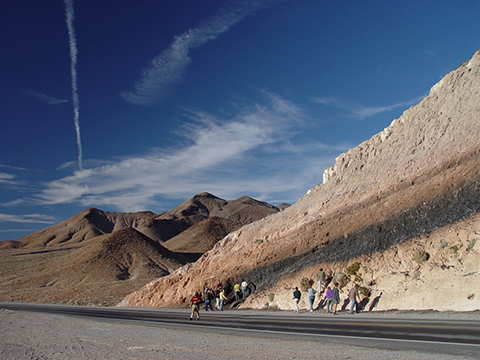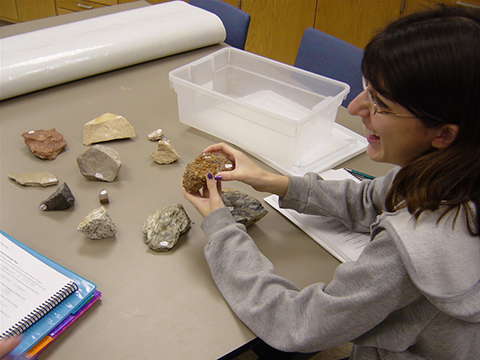Prelude
Terrestrial or Earth-like planets all have a metallic core and a rocky mantle and crust. The dominant rock types are composed of a variety of elements, with silicon, oxygen, aluminum, iron, and a few others being the most abundant. The resulting igneous, sedimentary, and metamorphic rocks all form under different conditions, ranging from a planet's interior to its surface. By understanding how some of these rocks form on Earth, we can interpret the geologic histories of other terrestrial worlds.
|
Figure 4-1. Rocks and minerals make terrestrial planets! MCC students visit the welded volcanic tuff exposed at Resting Springs Pass, California (left). Remember to click on the highlighted images to see larger versions. |
|
Igneous rocks are born of magma. Some magmas may rise quickly to the surface and erupt (volcanic), whereas others are destined to slowly cool and crystallize at depth (plutonic). We typically can name igneous rocks and interpret their origins by observing both the arrangement and type of crystals in the rocks. Volcanic rocks are the most common rock types known to exist on the surfaces of the terrestrial planets. Igneous rocks also can provide critical information about absolute age (number age).
Sediment is formed by the mechanical and chemical weathering of rocks on a planet's surface. Processes of flowing water, blowing wind, and moving ice distribute this debris to different environments, like river floodplains, beaches, desert sand dunes, or the bottom of the ocean. Compaction and cementation of the sediment over time represents the process of lithification, and sedimentary rocks are born. Because sedimentary rocks were once sediments, they record the surface conditions of the past (e.g., where they originated, how far they were transported, when and where they were deposited, etc.). Although these rocks may are less common on other worlds, their presence would signify the action of processes involving liquid (possibly water) and even organic life.
Metamorphic rocks have experienced changes due to heat, pressure and/or fluids, usually deep inside a planet. A pre-existing rock (the original or parent rock) can transform into a totally new (metamorphic) rock. The composition of the original rock and the intensity of the metamorphism determine how much the rock will change. Sometimes new minerals (like garnet) or even new layering can form in metamorphic rocks. All of these changes occur at depth, and only after the rocks are uplifted and exposed at the surface do we see the results metamorphism. The solid interiors of the terrestrial planets are likely composed of these rocks.
What Will You Do Today?
|
Describe, identify, and interpret various types of rocks and their constituent minerals. You will also learn the basics about isotopic age dating of rocks |
A. Elements & Minerals - Get familiar with some of the important rock-forming minerals and the elements that form them
B. Igneous Rocks - Identify and interpret different kinds of igneous rocks, the most abundant rock type exposed on the terrestrial planets
C. Sedimentary & Metamorphic Rocks - Identify and interpret different kinds of sedimentary and metamorphic rocks
D. Isotopic Age Dating - Learn about how specific "number ages" are determined for rocks


